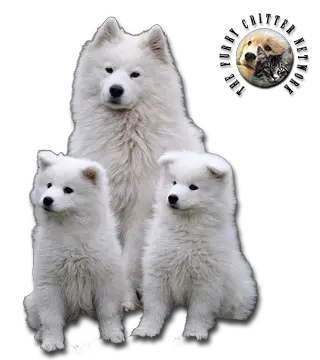General Description
These nomadic reindeer herders bred the fluffy white dogs to help with the herding, and to pull sleds when they moved.
Samoyed eyes are usually black or brown and are almond in shape. Samoyeds with eyes of other colors like blue exist but are not allowed in the show ring. The Samoyed is in the "brown and black section" in its family, the Spitz family.
Samoyed ears are thick and covered with fur, triangular in shape, and erect. They are almost always white but have a light to dark brown tint (known as "biscuit") to a greater or lesser extent. The tint is usually on the ears but can be visible on the whole body.
The Samoyed tail is one of the breed's distinguishing features. Like the Alaskan Malamute, the tail is carried curled over the back; however, unlike the Alaskan Malamute, the Samoyed tail is held actually touching the back. It is not usually held in a tight curl, or held flag-like; it is usually carried lying over the back and to one side. In cold weather, Samoyeds may sleep with their tails over their noses to provide additional warmth. Almost all Samoyeds will allow their tails to fall when they are relaxed and at ease, as when being stroked or while eating, but will return their tails to a curl when more alert.
Samoyeds have a dense, double layer coat. The topcoat contains long, coarse, and straight guard hairs, which appear white but have a hint of silver coloring. This top layer keeps the undercoat relatively clean and free of debris. The under layer, or undercoat, consists of a dense, soft, and short fur that keeps the dog warm. The undercoat typically sheds heavily once or twice a year, and this seasonal process is sometimes referred to as "blowing coat". This does not mean the Samoyed will shed only during that time however; fine hairs (versus the dense clumps shed during seasonal shedding) will be shed all year round, and have a tendency to stick to cloth and float in the air. The standard Samoyed may come in a mixture of biscuit and white coloring, although pure white and all biscuit dogs are common. Males typically have larger ruffs than females. While this breed is touted as "hypoallergenic", it does shed a fair amount and needs frequent grooming. While the breed may produce fewer allergens, care should be taken for severe allergies.
Shed Samoyed fur is sometimes used as an alternative to wool in knitting, with a texture similar to angora. The fur is sometimes also used for the creation of artificial flies for fly fishing.






